Related Research Articles
Catharism was a Christian dualist or Gnostic movement between the 12th and 14th centuries which thrived in Southern Europe, particularly in northern Italy and southern France. Followers were described as Cathars and referred to themselves as Good Christians, and are now mainly remembered for a prolonged period of religious persecution by the Catholic Church, which did not recognize their unorthodox Christianity. Catharism arrived in Western Europe in the Languedoc region of France in the 11th century. The adherents were sometimes referred to as Albigensians, after the city Albi in southern France where the movement first took hold. The belief may have originated in the Byzantine Empire. Catharism was initially taught by ascetic leaders who set few guidelines and so some Catharist practices and beliefs varied by region and over time. The Catholic Church denounced its practices, including the consolamentum ritual by which Cathar individuals were baptised and raised to the status of "Perfect".

The Medieval Inquisition was a series of Inquisitions from around 1184, including the Episcopal Inquisition (1184–1230s) and later the Papal Inquisition (1230s). The Medieval Inquisition was established in response to movements considered apostate or heretical to Roman Catholicism, in particular Catharism and Waldensians in Southern France and Northern Italy. These were the first movements of many inquisitions that would follow.

Pope Innocent III, born Lotario dei Conti di Segni, was the head of the Catholic Church and ruler of the Papal States from 8 January 1198 to his death in 16 July 1216.

The Albigensian Crusade or the Cathar Crusade was a 20-year military campaign initiated by Pope Innocent III to eliminate Catharism in Languedoc, in southern France. The Crusade was prosecuted primarily by the French crown and promptly took on a political aspect, resulting in not only a significant reduction in the number of practising Cathars, but also a realignment of the County of Toulouse in Languedoc, bringing it into the sphere of the French crown, and diminishing both Languedoc's distinct regional culture and the influence of the counts of Barcelona.

Pandulf Verraccio, whose first name may also be spelled Pandolph or Pandulph, was a Roman ecclesiastical politician, papal legate to England and bishop of Norwich.
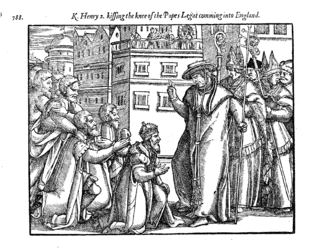
A papal legate or apostolic legate is a personal representative of the pope to foreign nations, or to some part of the Catholic Church. He is empowered on matters of Catholic faith and for the settlement of ecclesiastical matters.
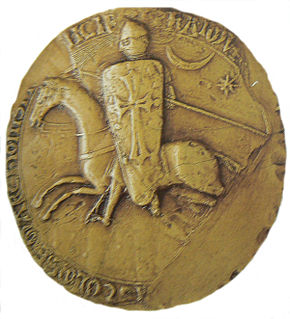
Raymond VI was Count of Toulouse and Marquis of Provence from 1194 to 1222. He was also Count of Melgueil from 1173 to 1190.
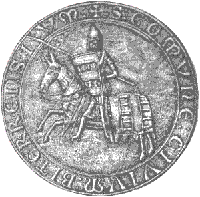
Raymond Roger Trencavel was a member of the noble Trencavel family. He was viscount of Béziers and Albi, and viscount of Carcassonne and the Razès.
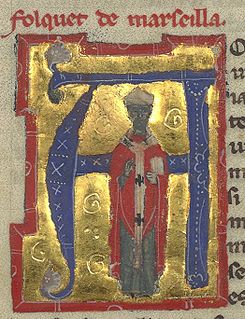
Folquet de Marselha, alternatively Folquet de Marseille, Foulques de Toulouse, Fulk of Toulouse came from a Genoese merchant family who lived in Marseille. He is known as a trobadour, and then as a fiercely anti-Cathar bishop of Toulouse.

Pierre de Castelnau, French ecclesiastic, was born in the diocese of Montpellier.
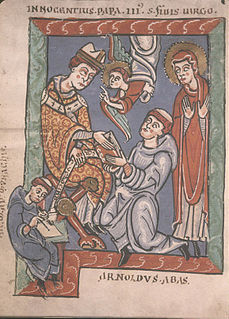
Arnaud Almalric was a Cistercian abbot who played a prominent role in the Albigensian Crusade. Prior to the massacre of Béziers, it was reported that Amalric, when asked how to distinguish Cathars from Catholics, responded, "Kill them all! God will know his own."

Henry of Marcy, or Henri de Marsiac, was a Cistercian abbot, first of Hautecombe in Savoy (1160–1177), and then of Clairvaux, from 1177 until 1179. He was created Cardinal Bishop of Albano by Pope Alexander III at the Third Lateran Council in 1179.
Giovanni di San Paolo was a Benedictine monk at San Paolo fuori le Muri in Rome. He was made cardinal-deacon on 20 February 1193, then cardinal priest of Santa Prisca in May 1193 and finally cardinal bishop of Sabina at the end of 1204. He is often referred to as a member of the powerful Roman Colonna family, but modern scholars have established that this is based on a lie from the beginning of 16th century. More likely he was nephew of Celestine III and member of the Bobone family. He studied medicine at Amalfi.
Pons d'Arsac was the Archbishop of Narbonne from 1162 until 1181. He was archbishop at an important time in the history of Narbonne and Languedoc in general; a time when the Roman Catholic Church denounced the local religious way of life as heretical.
Bernard Ayglerius was a French theologian, papal legate, and cardinal. He is sometimes known as Bernardus Cassinensis.
Pietro da Pavia, Can.Reg. was bishop-elect of Meaux (1171–1175), Cardinal-Priest of S. Crisogono (1173–1179) and finally Cardinal-Bishop of Tusculum. He was papal legate, together with Henri de Marsiac, in southern France against Cathars and Waldenses 1174–1178. He participated in the Third Lateran Council in 1179. Then he was sent again as papal legate to southern France and to Germany. He subscribed the papal bulls issued between October 14, 1173 and July 14, 1182. In 1180 he was elected archbishop of Bourges but it seems that he did not assume that post.

The Massacre at Béziers was the slaughter of the inhabitants during the sack of Béziers, an event that took place on 22 July 1209, and was the first major military action of the Albigensian Crusade.
"Caedite eos. Novit enim Dominus qui sunt eius." is a phrase reportedly spoken by the commander of the Albigensian Crusade, prior to the massacre at Béziers on 22 July 1209. A direct translation of the Medieval Latin phrase is "Kill them. The Lord knows those that are his own". Papal legate and Cistercian abbot Arnaud Amalric was the military commander of the Crusade in its initial phase and leader of this first major military action of the Crusade, the assault on Béziers, and was reported by Caesarius of Heisterbach to have uttered the order.

The Siege of Minerve was a military engagement which took place in June and July 1210 during the Albigensian Crusade in the town of Minerve in southern France. It was undertaken by the Catholic Crusaders against the Cathars in southern France, who were regarded as a heretical sect. The Crusaders, led by French nobleman Simon de Montfort, besieged and captured the town. The Crusaders allowed the soldiers defending the town, Catholics, and any Cathars who had not yet reached the status of perfect to go free. Three Cathar perfects who repented were pardoned, but 140 others who refused to do so were burnt at the stake.
Crusades against Christians were Christian religious wars dating from the 11th century First Crusade when papal reformers began equating the universal church with the papacy. Later in the 12th century focus changed onto heretics and schismatics rather than infidels. Holy wars were fought in northern France, against King Roger II of Sicily, various heretics, their protectors, mercenary bands and the first political crusade against Markward of Anweiler. Full crusading apparatus was deployed against Christians in the conflict with the Cathar heretics of southern France and their Christian protectors in the 13th . This was given equivalence with the Eastern crusades and supported by developments such as the creation of the Papal States. The aims were to make the crusade indulgence available to the laity, the reconfiguration of Christian society, and ecclesiastical taxation.
References
- ↑ St. Peter Pareuzi Catholic Online